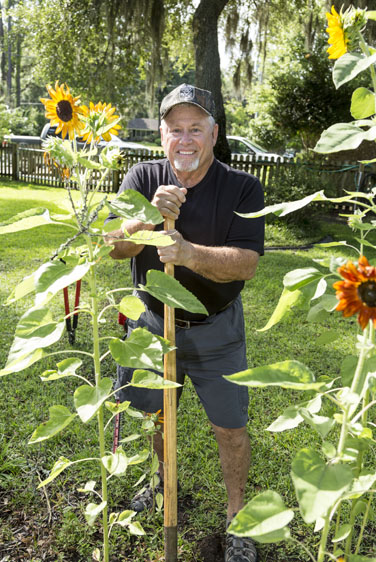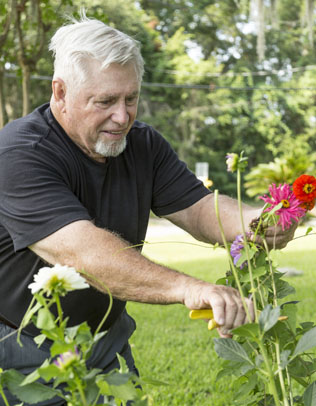Better Than Ever After Hip Replacement
December 14, 2014
“I don't even think about my hip anymore. I'm able to do all the things I used to do and then some."

Hazen Culley is no stranger to the OR. The 70-year-old retiree has had six operations on his back and neck, four procedures on his wrists, a bone spur removed from his heel, a bilateral mastectomy, cataract surgery on both eyes and work done on his knees.
“I’m the bionic man,” Culley quips. “That’s what comes from playing sports, jogging 5 or 6 miles a day and doing stuff like diving out of a boat going 40 miles per hour.”
As a young man, Culley played high school and college football. Later, while on active duty in the U.S. Navy, he earned a spot as
catcher
on the Marine Corps baseball team. He went on to serve 20 years as a medic in the Army and Air National Guard before retiring in 1995.
“I’ve had an active life,” Culley says, “and it’s taken a toll on my body.” Last summer, it was his right hip that finally wore out.

“I was doing a little jogging on the track at the gym, and all of a sudden I developed an incredible pain in my hip,” Culley recalls.
When the pain persisted six weeks later, he made an appointment with BMH orthopedist Kevin Jones, MD, who had operated on Culley’s right wrist in 2008 to treat carpal tunnel syndrome.
X-rays revealed the cartilage in his hip had degenerated severely.
Pain Reliever
“When you don’t have any cartilage in the joint, you have bone rubbing on bone,” Jones says. “The pain can be pretty severe.”
Typically, the initial treatments for osteoarthritis may include a steroid injection, arthritis medication and an exercise program.
“If all that fails and the pain is restricting the patient’s lifestyle, then we’ll start talking about surgery,” says Jones, who specializes in total hip and knee replacement surgery.
In Culley’s case, Jones recommended a cutting-edge procedure called anterior hip replacement. The technique has been shown to cause less pain, speed recovery and reduce the risk of dislocating the new hip after surgery.
Jones was the only physician in the area performing the advanced technique. “Anterior” refers to the way in which the surgeon gains access to the hip joint. In a traditional hip replacement, a 6- to 8-inch incision is made through the muscles of the buttock or the side of the hip. With anterior hip replacement, the incision is made at the front of the hip joint without having to cut through any muscle.
This creates less trauma to the soft tissues around the hip, allowing a quicker recovery. In addition, there’s a lower risk of dislocating the new prosthesis since the muscles used to support the hip joint remain strong.
“Patients experience less pain, get better faster and they don’t have to take the restrictive precautions that are required with traditional hip surgery,” says Jones.
The technique has proved so successful, Jones now uses it in more than 90 percent of his surgeries.
“It’s one of the most dramatic improvements in hip replacement in years,” Jones says. “The level of satisfaction with patients is very high.”
Just hours after his operation, Culley was out of his hospital bed and walking. “I’m a bit of an overachiever,” the veteran concedes. “They wanted me to walk 10 feet. I walked 20.”
Back in Business
During the two
days
he was in the hospital, Culley received physical therapy twice a day to get the muscles in his hip working again. As soon as he returned home, he began therapy three times a week in a Beaufort Memorial outpatient orthopedic clinic.
As she has been for all his surgeries and recoveries over the years, Jane, his wife of 47 years, was beside him every step of the way. Her support and encouragement were essential to his good outcome, he emphasizes.
“I did what they told me to do, and maybe a tad bit more,” Culley says. “That’s just my nature. I knew that if I did what they asked me to do, I would get my life back.”
For Culley, that meant playing golf, exercising at the gym, fishing, hunting, working in his yard and camping with Jane.
“It takes about six weeks for the soft tissue to heal,” Jones says. “After that, patients are able to resume their usual activity.”
Culley was back at the gym exercising as soon as his recovery was complete. A few weeks later, he hit the fairway.
“I took it easy,” the retired insurance claims adjustor says. “I only played nine holes.”
Today, he’s back to his old self and pain-free.
“I’m immensely happy with the results,” Culley says. “I have no discomfort whatsoever. I don’t even think about my hip anymore. I’m able to do all the things I used
do
and then some.”
